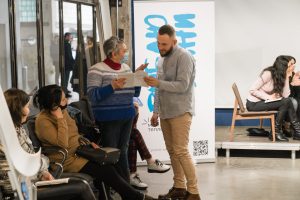The best things are often born when people do not wait for a mythical superhero to come solve their problem but undertake to improve life around themselves. We share inspiring examples of such Ukrainian initiatives.
English school for children from low-income families in Sumy, the centre of leisure and integration of migrants and the Kramatorsk literary festival, installation of ramps in the Kherson Theatre – all these are charitable projects of local community foundations.

Training Small Grants School in Promprylad.Renovation headquarters. Photo: Facebook page of Warm City, provided courtesy of the Zagoriy Foundation.
Such foundations operate locally – in one or more settlements – and collect donations mainly from the community. Then the money is spent on projects created in partnership with local utility companies, non-profit organisations, enterprises.
The culture of community foundations in Ukraine is developed by Yednannia Initiative Center – in particular, it conducts schools for beginners and provides grants for organizational development.
The largest foundation like this with its own budget is Podillia Hromada. It is working on various initiatives – from grant support for Vinnytsia doctors to free IT hackathons and scholarships for talented musicians. The purpose of the foundation is to help the city develop and make Vinnytsia interesting not only for citizens but also for tourists.
Who else if not a foundation?
In the last five years, a format of hubs set up by local activists and social entrepreneurs has become widespread.
Berdiansk anticafe CHAS YE in cooperation with the program City Code and curators conduct urban research, create a new identity of Berdiansk and develop a landscaping strategy. Also, they bring the Week of Austrian Cinema to the city, and for a couple of years, they run an English-speaking club.
The free space DRUZI in Kostiantynivka was arranged by the club of Docudays film festival. Environment trainings are also held here (including with the artist Alevtyna Kakhidze), as well as the lectures on classical music and other events.
Pokrovsk Youth Hub (Donetsk region) organizes cycling schools, teaches project management and the basics of local business. Pokrovsk also has its own volunteer garbage sorting facility with an awareness-raising page.
Often, local initiatives involving civil society development, urban planning, environment protection or cultural projects are funded through international grant programs. Local donors often focus on urgent issues – the treatment of the seriously ill, the support of the army, the arrangement of parks and squares, and so on.
Good start
However, there are exceptions. The mission of the Warm City platform is to use the example of Ivano-Frankivsk to encourage change in Ukraine and beyond. And although the organization is known primarily due to the projects Urban Space 100, Urban Space Radio, Promprylad.Renovation, Warm City is also famous for its small grant program.
It is designed to support local initiatives that work with the themes of urban space, contemporary art, recreational opportunities, development of education and entrepreneurship, etc. It is important that the grant program is funded only by an international donor, but also by local entrepreneurs.
The Small Grants School teaches applicants to write applications effectively. Over time, this skill will help open the door to collaboration with larger donors. The winners are chosen by a selection panel consisting from local activists. They are well aware of the needs of the community, as opposed to experts from large grant programs who live in other cities or countries and often lack understanding of local context.
Where to start?
Local initiatives require the same structural thinking as large-scale philanthropy. Here are some questions to ask yourself before creating a useful local project.
1. What problem in the city are we trying to solve?
After identifying the problem, it should be investigated: conduct a survey, find out the needs of people, talk to experts.
2. Has anyone already dealt with this issue?
If so, join forces and experience.
3. What are our long-term goals? What contributes to the sustainability of the strategy?
For successful development, the project should be planned a few steps ahead, immediately prescribe the risks, and the criteria for measuring its effectiveness.
4. How will we attract donors?
Look for non-standard perspectives of cooperation. If the project is aimed at cultural or infrastructural development, give world examples, show the advantage of your approach for all.
5. What messages do we use? Do we have a person on the team who writes easily and knows the basics of SMM?
Choose communication platforms that will work for both the local community and the external audience (that is, potential donors and partners).
And finally: as everywhere, in good deeds you should learn from the mistakes of the others. Read this article to learn about failed decisions in philanthropy and how to avoid them.
Valeriia Buradzhyieva is the author of The Media of Great Stories — media about charity in Ukraine founded by Zagoriy Foundation.
This article was first published on The Media of Great Stories, it is being re-published in Alliance with permission.



Comments (1)